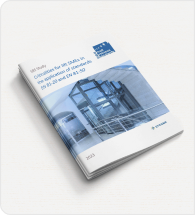“Responding to the applicability of the Radio Equipment Directive (RED, 2014/53/EC) – Hardware/Software disaggregation and support for horizontal market”
Background
The Radio Equipment Directive 2014/53/EC (RED) establishes a regulatory framework for placing radio equipment on the EU market. Due to the digitalisation, this directive has gained in importance as the scope of the RED covers devices that use the radio spectrum for communication and/or radio determination purposes. All internet-connected wireless devices (including e.g. IoT devices) fall under this Directive. The RED ensures that radio equipment, at the moment of its placing on the market, respects the essential requirements of the Directive as regards e.g. health and safety, electromagnetic compatibility and radio spectrum . Radio equipment can change its behaviour or be reprogrammed at the upload of new software this is the key feature exploited by reconfigurable radio systems (RRS). A variety of equipment placed on the market can be reconfigured through software. There is an issue when it comes to legal certainty when placing RRS on the market.
The European Commission is currently investigating the extent of the applicability and issues of liability related to the RED. This may lead to an update of the technical framework by drafting delegated acts based on its Article 3(3)(i). The Commission has therefore carried out an impact assessment that should provide input given problems related to reconfigurable radio systems on the one hand and possible solutions and their consequences on the other hand. Further, the European Commission has published an Open Public Consultation (OPC) which aims to gather feedback from relevant stakeholders about the market access conditions of wireless devices which are connected to the internet or wearable . Specifically, the need for strengthening 1) (i) data and privacy protection, and (ii) protection from fraud is being considered. According to the received feedback and the impact assessment as well as the input received via the RED expert group, the Commission may consider different policy options to strengthen the trust in the field of wireless devices and their applications. Specific mandatory requirements would concern the activation of
one or more delegated acts pursuant the Radio Equipment Directive 2014/53/EU.
In practice, these delegated acts would require that wireless devices (or some of their radio components) could not be placed on the EU market unless a satisfactory level of protection of data and privacy and/or from fraud is demonstrated. If not done well, this may lead to a lockdown of reconfigurable systems due to concerns about data protection and fraud, thus limiting the innovative potential of the market.
WHAT’S AT STAKE FOR SMALL AND MEDIUM SIZED COMPANIES IN THE ICT SECTOR?
As in other fields, SMEs play a significant role in providing innovation, fostering competition and reducing product costs. Protecting SMEs means fostering the ability of the EU to innovate and to compete in global markets. SBS is concerned about the possible negative impacts of the proposed Delegated Act on the ability of SMEs to bring innovation in the radio equipment market. Specifically, SBS is concerned about any measure that could present an obstacle for SMEs to bring their product to the market and that could hinder the development of a horizontal market.
A horizontal market is a market in which customers can buy hardware and software from different vendors combining them into a system. This process offers a great degree of flexibility and cost reduction. Thus, a horizontal market could lead to increased innovation, higher value, lower hardware costs, lower operating costs, lower switching costs and higher allocative efficiency.
In addition, horizontal market would have a significant impact on the reduction of Waste Electrical and Electronic Equipment (WEEE). The possibility to upgrade hardware or to integrate it with new interfaces prevent the premature disposal of electronic equipment. Therefore, development of the horizontal
markets would allow to reduce the amount of WEEE, as it is requested by the WEEE Directive (2012/19/EU).
Due to limited resources, European SMEs are more prone to innovate in software rather than on hardware. Software is in any way the area where most of the innovation is taking place. As a consequence, they rely on hardware manufactured by 3rd party large enterprises. To continue their activity, they need a certain degree of openness. In essence, a horizontal market is possible when a clear legal framework sets the foundation for hardware/software disaggregation, which would grant SMEs the right to develop their software on existing hardware.
The applicability of the RED and potential delegated acts have the potential to prevent or to promote software/hardware disaggregation. Consequently, impacting the development of a horizontal market for wireless devices which are connected to the internet or wearable in the EU. For this reason, any RED delegated act or other measures need to consider the possibilities and/or impact of preventing the creation of a horizontal market.
As a general concept, any procedure or mechanism that would increase the complexity or costs to combine software and hardware provided by different manufacturers may negatively impact SMEs innovating in this space.
Proposals on the implementation of articles 4 and 3.3.(i) of the RED
In the following, SBS presents its position on both topics of Reconfigurable Radio Systems (RRS), and the Privacy and Fraud protection. This position paper examines articles 3.3.(i) and 4 of the RED. These proposals aim to ensure that the applicability of the RED and proposed delegated acts will allow to the creation of a horizontal market for wireless devices which are connected to the internet or wearable in the EU.
SBS commentary on Article 4 and on options proposed in European Commission impact assessment.
There is a need to clarify responsibility and liability. Otherwise, there is a high risk that the market will regulate itself on the basis of article 4 and standard EN 301 893. The standard in combination with article 4 statesthat if a software is loaded by the user, it could revoke the essential requirements set out in article 3, and therefore make the hardware vendor liable. Therefore, vendors will likely decide to lock down the hardware in order to avoid compliance issues. There is a need to clarify this with a delegated act – otherwise, innovation and a horizontal market will be hindered. The standard is even worse: standard clearly say that if radio is configurable, then it’s not compliant.
SMEs need a clear legal framework in order to continue developing software that works on third party hardware. The status quo, instead:
- Does not provide clarity about liability. Without clarity, hardware vendors will be driven by the fear of possible liabilities generated by software vendors and will protect themselves with hardware lock-down. This may occur in particular if EN 301 893 applies.
- If Option 1-1 is adopted, industry is left to self-regulate. Without a framework to clearly waive hardware vendors from liabilities potentially generated by software, will not
drive to a horizontal market creation and, instead, risks to be counterproductive.
How can this be avoided?
- Software vendors should be able to declare their software as conform, via a procedure that allows them to take their responsibilities, without adding significant
costs or delays to time-to-market, and without interference by third parties.
Conclusion: Article 4 should not involve any upload filter and provide a simple liabilities assignment framework via a delegated act. Software vendors may simply self-declare that their software does not compromise the essential requirements and take responsibility for this.
Further recommendation: the RED application should be addressed in a way that fosters the horizontal market not only via delegated acts, but also inviting the standardizing bodies to specifically avoid measures that damage the horizontal market in standards. This could have, in some cases, the side-effect of significantly reducing non-compliance, such as in the DFS high non-compliance rate (see the EG RE (03)15 – ADCO RED report to EG 03). This comes from the clear divergence between market needs for reconfigurability and the philosophy behind standard EN 301 893, which clearly does not envision the horizontal market with regard for the DFS aspect.
SBS commentary on Article 3.3.(i)
With a clear framework defined in Article 4, there will be no need for a delegated act. However, as the European Commission also wants to regulate privacy and fraud protection, this should at least be done in a way that does not impact too much on the horizontal market and avoids hardware lockdown.
- Article 3.3.(i) should not be implemented, and Article 4 should be enough to allocate responsibility to the proper party (being it the hardware manufacturer, the software
manufacturer or the user), except for classes of devices that imply significant risk in relation to privacy and fraud protection. - Regarding classification, it’s important to state that the risk class should depend not only on the device classification but also on the specific design: a device of a specific
class, e.g. IoT or Wi-Fi Routers, could be risky or not based on how the hardware and software are designed. A design that allows partial modification of software, with no
ability to change the parameters that impact the essential requirements, should not be considered risky at all and then 3.3.(i) should not be applicable. Therefore, treating
devices of the same class indistinctly of the design choice would represent an obstacle for the industry to find solutions that meet the required level of protection. - In case 3.3.(i) is applied to any specific class of devices, it should be implemented in a way that does not negatively impact the creation of a horizontal market
Conclusion: SBS recommends limiting the application of 3.3.(i) to devices that have a significant privacy/fraud protection risk, where the risk is evaluated also accounting for the product design. Where 3.3.(i) should be applicable, SBS considers the following points as the main requirements for any 3.3.(I) implementation to avoid the destruction of a horizontal market:
a. The 3.3.(i) mechanism should not provide any veto power to hardware vendors. Even with a proper liabilities allocation framework, large multinational hardware
vendors may not have a strong reasons to promptly take care of SME software vendors requests to enable their software (e.g. distributing a key or signing a firmware), and actively or passively obstruct them, delaying and in the worst-case sending them out of business. For a true horizontal market to happen, software
vendors should be able to load their software ready on third party hardware without any kind of interference by hardware vendors.
b. The 3.3.(i) mechanism should not increase costs sustained by the software manufacturers. A self-certification may be acceptable.
c. The 3.3.(i) mechanism should not delay the go-to-market.
d. The 3.3.(i) mechanism should not create extra complexity for the user who intends to combine software and hardware (it should ideally work in a click), as any
complexity increase may represent an obstacle to adopt a disaggregated solution and to benefit from its cost-reduction.
e. The 3.3.(i) mechanism should ideally work on offline devices. Installing new software on offline hardware units may become significantly more
expensive if those units request to be configured and go online before they can receive the new software. The person installing would be required to configure each of the Wi-Fi routers deployed, e.g. 50 routers to be installed in a school, to have these online before uploading the new software. Instead, the same operation may be executed with a single click in case configuration is not required. This latter option would be operationally more efficient and would reduce the costs for the school to adopt a horizontal software on 50 units. See the last paragraph for a detailed
example.
The above list defines the requirements of a “horizontal market friendly” implementation of 3.3.(i). To conclude, we’d like to focus on a specific use case, i.e. the “Installation of a Wi-Fi network in a school with limited budget”. Capacitating the horizontal market means enabling significant cost savings, increase allocative efficiency and serve the underserved ones. For this reason, we request that the impact on such use case of any implementation of 3.3.(i) is foreseen.
Case study: Example of benefits provided by the horizontal market in the education vertical market
The typical school in low income European regions can afford only 20 Eur Wi-Fi off-the- shelf routers, which use radio chipsets similar to the ones of 500 Eur Enterprise Wi-Fi routers. A 3rd party software can upgrade them and add features such as protection from viruses/pornography, at a fraction of the cost of Enterprise Wi-Fi solutions that provide similar features. The cost saving on hardware can be up to 20x and the TCO and be reduced to a fifth.
The following example refers to the two options of a school that requires 30 Wi-Fi routers: PROPRIETARY SOFTWARE/HARDWARE SOLUTION (NO HORIZONTAL MARKET)
Hardware: 500 EUR x 30 unit = 15.000 EUR (capex)
Installation: 5.000 Eur (capex)
Software cost: 100 Eur/year/unit (opex)
TCO FOR 5 YEARS: 500 Eur x 30 + 5.000 Eur + 100 Eur x 30 x 5 = 35.000 Eur
DISAGGREGATED SOLUTION (HORIZONTAL MARKET)
Hardware: 20 EUR x 30 units = 600 EUR (capex)
Installation: 5.000 Eur (capex)
Software cost: 5 Eur/year/unit (opex)
TCO FOR 5 YEARS: 20 Eur x 30 + 5.000 Eur + 5 Eur x 30 x 5 = 6.350 Eur
A complex software installation process, i.e. that does not meet all the a – e properties, would discourage the user from adopting a sw/hw disaggregated solution, leading to the horizontal market failure. The school would miss the opportunity to be served thanks to a software solution that can be provided by the software manufacturer at a marginal cost close to zero




























